How to plant and care for thuja correctly?
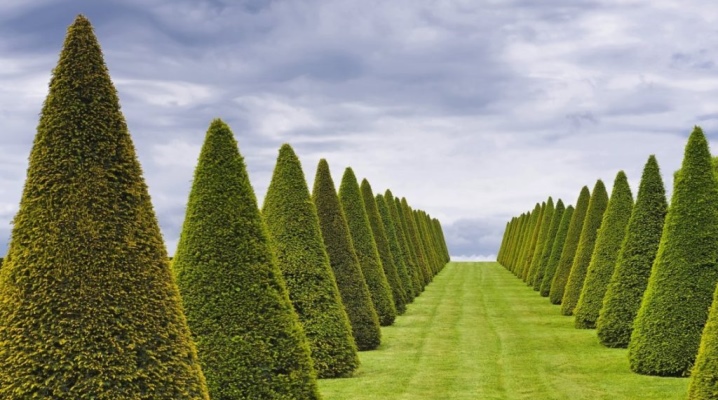
Thuja is a popular evergreen tree that can often be found in the landscape design of summer cottages and private territories. This tree is distinguished by frost resistance, endurance and powerful immunity, which allows it to survive significant cold weather. In this material, you will learn how to properly plant and care for thuja after planting in open ground.
The right time
The best time for planting thuja in open ground is the first months of spring, the time period before the start of sap flow (movement of water and nutrients from the roots to the crown and branches of the tree) is considered optimal. It is difficult to indicate the exact dates of disembarkation due to the instability of weather conditions - be guided by the temperature of the earth, night frosts and temperature drops. Planting dates can vary significantly depending on the region: for example, if in the Moscow region this is the period from March to April, then in Siberia it would be better to wait for the summer season with a lot of sun.
For so that thuja seedlings feel as comfortable as possible in a new place, the earth must be moist and warm... Usually, for planting, a period of time is chosen from the end of March to mid-April, it is believed that it is at this time that the phase of active growth of shoots and roots of thuja takes place. The presence of this period of time allows not to be afraid of the possibility that thuja seedlings will not take root in a new place.
Planting thuja seedlings in spring allows them to grow long enough roots to painlessly survive the coming winter and not freeze.
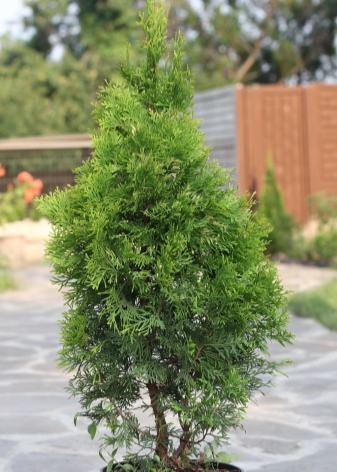

Suitable for planting thuja and summer, however, in this case, the process of caring for the plant becomes more complicated. Drying of the root system with insufficient moisture level is characteristic of all conifers. Thus, young seedlings with short roots are not able to provide themselves with moisture on dry days, and this leads to their extinction. In this case, the landing procedure should be carried out as quickly as possible; for disembarkation, you should choose a cloudy day with an air temperature of no more than 20 degrees. Some people prefer to plant thuja on a summer morning.
You can plant thuja in the fall, but in this case, keep in mind that the seedlings will not have time to form the root system before winter. Only strong roots allow trees not to bend in the frosty wind and a lot of snow. The condition of the roots can also be affected by the heaving of the soil, which is able to deform the growth of the root system and tilt the thuja. To make the thuja tree feel as comfortable as possible in this situation, you need to properly tamp the soil around the trunk of the seedling and tie it to a metal support.
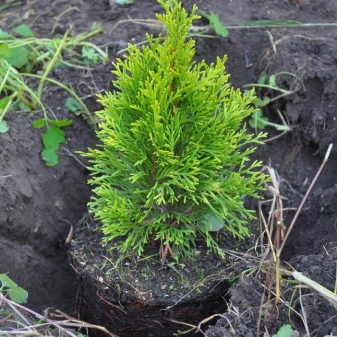
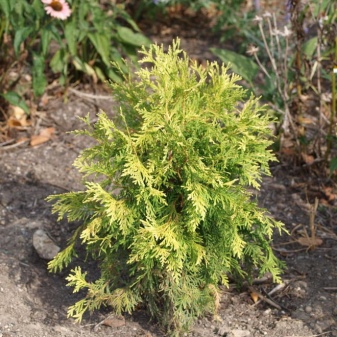
Choosing a variety for planting
Today, a large number of different varieties and varieties of thuja are known. According to the place of origin, they are divided into western and eastern. Western thujas are more common, here the most famous variety is "smaragd" (less - "brabant", "teddy"). The popularity of Western varieties is easily explained - they are easy to care for, grow quickly and rarely die in winter.
The classification of tui is known, based on their shape, here they are: dwarf, spherical, pyramidal and conical... In landscape design, conical and pyramidal thuja look best. To decorate the garden and decorative paths, it is better to use dwarf or spherical varieties of thuja (Danica, for example). For the formation of a decorative flower garden, decorative thujas are suitable - the same "teddy".
Remember that there are many varieties of thuja, but when choosing it is worth paying attention to the immunity of trees, their adaptability to the environmental conditions in your area, and then to the appearance.
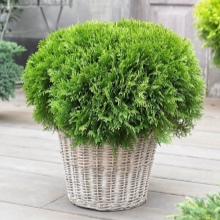
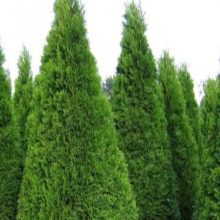
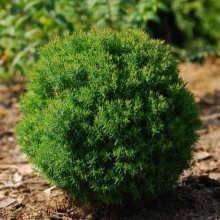
Reproduction methods
There are two ways to propagate thuja at home: using seeds and by cuttings. What are the pros and cons of each of them will be indicated below.
Seeds
- This method is not particularly popular among gardeners, since it takes a huge amount of time - in rare cases, up to 6 years. All because of the need to provide conditions for natural stratification.
- Even in spite of all the efforts that you will make in this way, the chance to preserve all maternal qualities is not one hundred percent here.
- Initial seed care is not as painstaking as for cuttings. In addition, thuja seeds are much easier to obtain and cheaper to buy than good cuttings.
- None of the modern ornamental varieties of thujas are grown using seeds - it is believed that thujas grown from seeds are weak and prone to more infections and diseases.

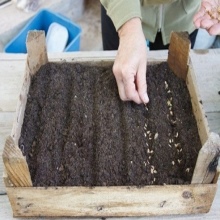
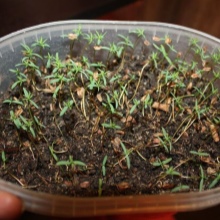
Cuttings
- Cutting with almost full probability will retain the specific features of the appearance of the mother thuja.
- This method of reproduction allows you to get strong thuja seedlings in about 2-3 years.
- Unfortunately, this method does not guarantee you the survival of all seedlings during the reproduction process. As a rule, no more than 70% of the total number of cuttings survives, even with the most careful care.
Regardless of which of the methods you have chosen for breeding at home, remember that this is painstaking and long work that may not pay off on the first try. That is why try to divide the seeds or cuttings into separate pieces and harvest them at short intervals.
This way you will learn from your mistakes.

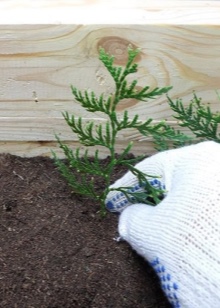
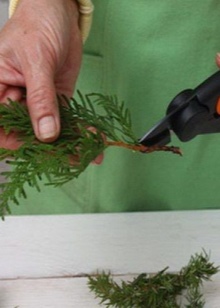
Selection of ready-made seedlings
When choosing thuja seedlings ready for planting the following rules should be followed.
- The symmetrical shape of the seedling speaks of a healthy root system and strong immunity.
- The more dense and lush a seedling, the better its roots will develop in the future.
- The optimal color for a seedling is dark or light green, depending on the variety. Seedlings with brown and yellow needles should be discarded.
- Pay attention to the pot in which the future tree grows. If it has holes and cracks through which thick roots grow, it means that it has not been sold for a long time.
- Evaluate the bark of the ephedra - it should be flat, without wounds or painful areas.
- By the elasticity of the needles, one can judge whether the tree is alive or not. In a healthy and lively ephedra, the needles should be elastic.
- Weeds in a pot are a sure sign that thuja has been there for a long time and feels great. Large weeds indicate a successful winter.
- If possible, the lower roots should be examined - they should be white with pinkish tints.
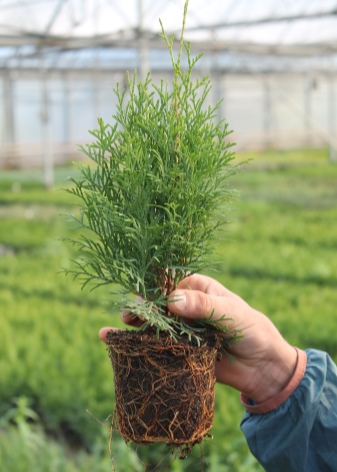
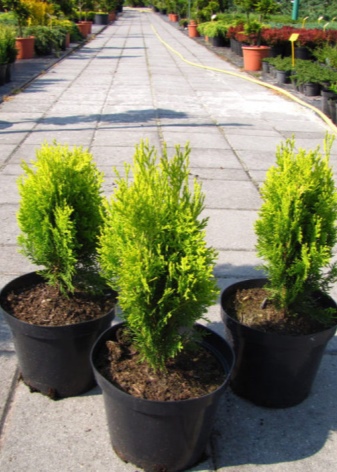
Landing technology
Thuja planting procedure takes place in 2 stages:
- site selection and preparation;
- the landing itself.
Each of the steps will be described in detail below.
Drop off location
The place where you plant the thuja will fully determine the successful growth of the tree: the intensity of moisture intake, sufficiency of light, saturation of the soil. Before choosing such a place, gardeners recommend paying attention to the following rules.
- Light. Remember - not a single coniferous plant likes excess heat and direct sunlight.With prolonged exposure to the sun on the needles, it begins to rapidly turn yellow and fall off, which is why it is recommended to plant thuja in an area with slight darkening. At the same time, strong shading inhibits the processes of photosynthesis and slows down the growth of the tree itself, the lack of sun affects not only the intensity of growth, but also the saturation of the color of the needles - it becomes pale, weak and rough to the touch (the crown of the tree itself is thinning). The ideal option would be a place where the thuja would remain in the shade in the morning and afternoon, and in the evening under the sun.
- Wind. When planting a thuja in open ground, it is also worth considering the strength of the wind flows. So, for example, too strong wind in winter, autumn or spring can harm the fragile branches of a young thuja. It is recommended to plant thuja in the spring - at this time there is least cold wind. When exposed to strong wind currents, it is recommended to tie the thuja to a reliable support or install a solid partition to protect it.
- Moisture. In order for the thuja to look beautiful, it is necessary to provide it with a constant flow of moisture. This can be achieved either by systematic watering, or by planting a tree in a place where the groundwater would be as close to the surface as possible. In this case, it is better to limit independent watering of the thuja, otherwise a large amount of moisture will simply lead to rotting of the root system.
- The soil. Thuja is not particularly picky about the type of land, it grows well both on clay and peat soils, and on sandy loam, loam. The main condition for the soil is a sufficient amount of moisture for the development of new sprouts of needles. If you decide to plant it in clay soil, then the bottom of the planting pit should be sent with a drainage layer or a layer of sand to drain excess moisture. If we are talking about peat soils, here special drainage pipes are used to drain water. The ideal soil option for the successful cultivation of a beautiful thuja is a mixture of sod-podzolic, peat and sandy soil - it can be easily made at home.
- A place. Tui are greedy trees that require a constant flow of moisture, which is why they should not be planted close to massive and old trees or next to plants with a powerful root system. Keep in mind that tall and close-planted thuja eventually form a dense plant fence, so many people prefer to plant these trees near the house or in the yard as a living fence.
- Pit. The size of the pit for planting should also be considered carefully - take into account the type of soil and the size of the future crown of the tree itself. With a tree crown diameter of 70 cm, the diameter of the hole should be at least 60 cm.At the same time, much depends on the type of soil - if you have light and fertile soil in your country house, a not particularly large hole is also suitable here - the roots of the thuja will pave their way over time ...
If your garden has heavy soil, make the hole as wide as possible.
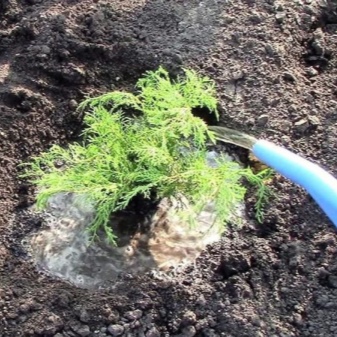
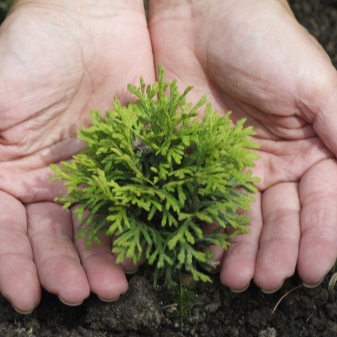
Landing procedure.
Planting any tree follows certain instructions, which will be indicated below. This guide has been written for both beginners and experienced gardeners.
- Choosing a landing site.
- We dig a hole to the required depth, install drainage.
- We prepare the soil for planting - you can use both ready-made soils for thujas, and those made with your own hands.
- About half an hour before planting the seedling, it is worth sprinkling it with a root formation stimulator (for example, "root").
- Before planting thuja on top of the drainage layer, place the soil in such a way that the beginning of the root system of the tree rises 3 centimeters above ground level. The fact is that the ground will subside in the future and the tree will be on the same level with the ground. At the same time, you should not overdo it with these levels - if the altitude is too high, there is a great chance of exposing the roots to the sun, and if it is too low, to the effect of excess moisture.
- If you bought a seedling in a pot, you should put it on its side (on a hill inside the pit) and carefully pull the seedling along with all the soil behind the base. To make the clump of roots and soil come out better, simply tap the pot with a spatula. If you are dealing with a peat pot, pulling a seedling out of it is not necessary. Place the seedling in the hole and sprinkle with half of the prepared soil, tamp lightly and pour at least 1 bucket of water into the hole. When moisture is absorbed into the ground, fill the hole to the end and lay mulch on the ground - it will retain moisture in the upper soil level and create a pleasant microclimate.
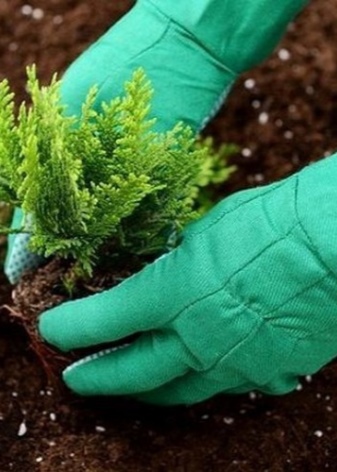

Transfer to a new location
Often, gardeners have to replant their plants due to changes in growing conditions: lack of space for growth, lack of heat or moisture from groundwater, poor soil quality when first planting. If you want to painlessly transplant thuja to a new place, you should adhere to the following rules.
- Roots. Thuja has long and rather powerful roots that go far into the ground. Your main task when transplanting a thuja is not to cause significant damage to the roots. In no case try to pull the thuja out of the ground by the top - you will certainly harm the roots and provoke a stressful situation in the tree. To transplant thuja as painlessly as possible, you should dig it up with a shovel from 4 sides and try to pull out the entire root system along with the earth. Do not forget to prepare a pit of sufficient size in advance, and then place the pit along with the earth in the pit, filling the gaps in the pit with natural fertilizer or ordinary earth. Do not forget to tamp the soil so that the first strong wind does not bend your tree.
- Watering. Do not spare water when transplanting this ephedra. In addition to the fact that the new hole for the tree should be thoroughly watered, after planting the thuja, it should be well watered again. In the first days after planting, water the tree several more times and make sure that the water does not stagnate at its base - this is a sign that there is enough moisture at the moment.
- The soil. The soil in the new place should be not only moist, but also loose and nutritious. Remove all weeds and stones from the soil.
Remember that any tree transplant is a real stress, the result of which depends only on your attentiveness and efforts.

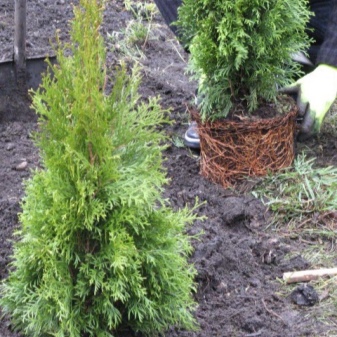
Correct care
It is not enough to find a healthy seedling and the right place to grow a good thuja. To prevent the plant from drying out, looking healthy and beautiful, it must be regularly and properly looked after after planting.
Watering
Tui are very fond of moisture, they grow faster from a large amount of water, and the color of the needles becomes bright and saturated. The ideal option would be systematic watering with small portions of water several times a day. Constantly monitor the water level at the trunk of the thuja - keep in mind that stagnant water is harmful to every coniferous plant.
Most owners choose to water these ornamental trees with automatic sprinklers. - they provide a constant flow of fresh and cool water in small portions, and also clean the needles from dust and dirt.
If we talk about portions of moisture, then a thuja seedling will need at least 2-3 buckets of water for active and full growth per week. The amount of moisture should be increased in the very first days after planting. Watering itself is best done in the morning or in the evening - at this time of the day, most of the moisture goes into the roots, and does not evaporate in the sun. After the watering itself, the land near the thuja should be cultivated and loosened so that moisture can calmly reach the roots, and not linger at the surface, saturating the weeds.
The lack of water can be guessed by the condition of the needles - with a small amount of moisture, it turns yellow, dries and falls off.
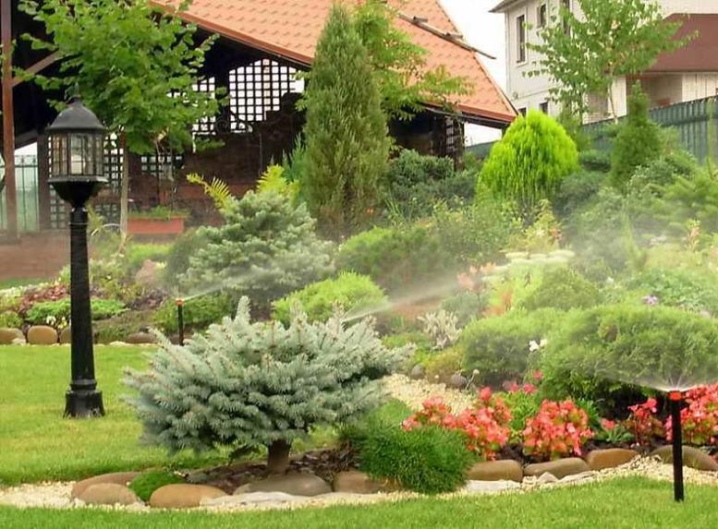
Top dressing
The soil for planting thuja should be not only moist, but also rich in nutrients, which is partly why it is recommended to plant young thuja in peat pots. They provide primary feeding for thuja and do not disturb the root system when planted in open ground. Further feeding should be carried out no earlier than six months later. That is, if you planted thuja in the spring, then in the fall you should carry out another one - in order to make it easier for the tree to survive the winter cold.
As a top dressing, it is better to choose urea or ammonium nitrate, in this case, the fertilizer is simply placed in the soil at the base of the thuja. In addition to these fertilizers, there are also specialized soil additives specifically for conifers. Unlike other ornamental plants, systematic soil feeding is not recommended here.
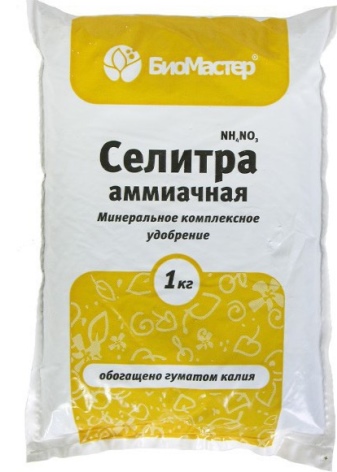

Pruning
Some owners consider pruning thuja an optional activity, since modern horticultural technologies have made it possible to distinguish several separate varieties of thuja with a pre-formed crown shape: round, pyramidal or rectangular. However, the fact is that even with proper care of conifers, the growth of adventitious processes, which spoil the entire appearance of the ephedra, cannot be completely avoided.
The main reasons for pruning thuja will be presented below.
- Health improvement and prevention. Pruning allows you to remove dried branches and diseased parts of the crown from the crown. With pruning, you can easily remove diseased or infected branches to keep the infection from spreading to the entire crown. Keep in mind that if the thuja branch itself is alive, but yellow dried parts are observed on it, sometimes it is enough to remove only the dead parts - in this case, it is likely that the rest of the needles will continue to grow.
- Appearance correction is the most common reason for cropping. With this procedure, you correct the shape of the thuja - remove the processes that spoil it. Often pruning involves cutting off the top if it is dry or interfering with the development of the lower and side branches. Thus, the thuja is given a lush appearance, and the lower branches receive more light and nutrients.
- By removing excess, old or dead branches, young shoots receive more nutrients, air circulation inside the needles improves, and the risk of parasites and insects in the plexus of branches is reduced.

Best trimming time.
Fortunately, almost all conifers are immune enough to tolerate pruning at any time of the year. Pruning of some types of thuja is carried out 3 or even 4 times a year. This indicates that the main thing in pruning this plant is not the pruning time, but its literacy and regularity. There are no certain strict deadlines during which you could be more successful in pruning thuja. The main condition here is cloudy weather and an outside temperature of at least 5 degrees with a plus sign.
If this condition is not met, the cut thuja branches will heal much longer and are more likely to dry out.
Pruning procedure.
Step-by-step description of the thuja pruning procedure looks like that:
- examine the crown of the thuja, remove all diseased, dry or damaged shoots;
- remove some of the inner branches - this will provide a passage for fresh air;
- if you want to increase the length of the lower branches, remove part of the top of the thuja;
- to maintain a certain shape, systematically remove overgrown protruding branches, as well as last year's shoots;
- do not overdo it with the accuracy of trimming, your main task is to give it a pleasant appearance;
- if you did not have time to prune in the fall, carry it out in the spring; after winter, be sure to inspect the ephedra and remove all dried or frozen branches.
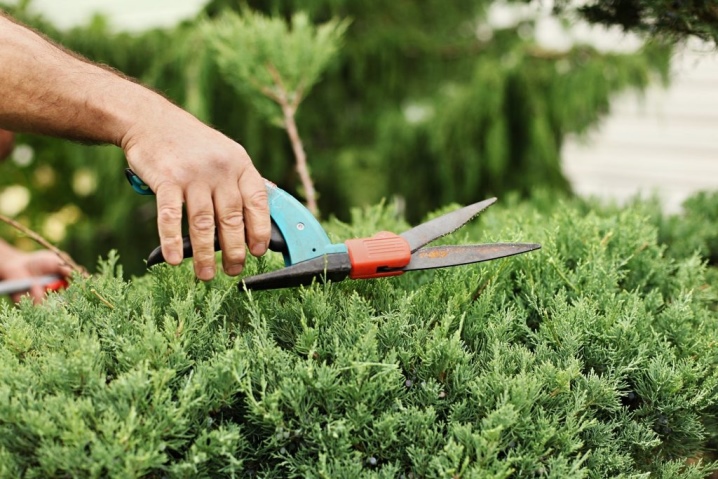
Haircut options.
The most common are 3 options for cutting thuja: topiary, ball, spiral.
Topiary haircut is the intentional giving of a certain size and shape to the crown of a plant using metal models. These patterns or shapes are installed directly above the ephedra to control the growth of the crown in the desired direction. Over time, the form is filled with thuja branches, and excess shoots are regularly removed.
In approximately the same way, spherical and spiral haircuts are formed, however, to maintain shape, close care of the tree, as in a topiary haircut, is not required.
Experienced gardeners believe that the installation of a metal model on a thuja (or manual shaping) should be carried out only a year after the first thinning of the tree.
During this period, the thuja must completely restore the shoots and painlessly transfer further pruning.
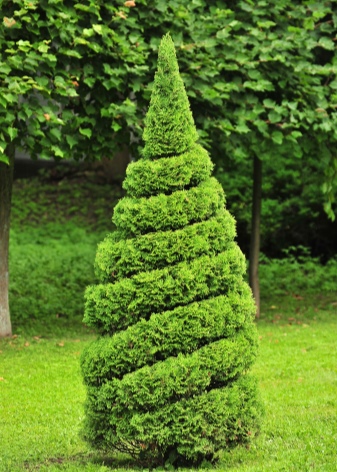

Preparing for winter
Fortunately for all gardeners, thujas have an incredibly resistant to frost and temperature extremes, due to which they are able to endure even the most severe winters without any particular problems. However, some of the modern thuja breeds were bred exclusively for decorative cultivation, which led to the degradation of most of the protective qualities. In addition, even despite the immunity of a certain seedling, it still remains weakly resistant to frost until its roots go deeper into the ground.
The main task in preparing the thuja for winter is to cover and insulate the tree. Experienced gardeners prefer to shelter not only the roots of the plant, but also its crown from snow, frost, pests, as well as from the bright sun, which usually happens at the very end of winter. Preparation for winter is expressed in the following.
- The first stage is the preparation of the mulching material. This material is a shelter made of natural (manure, peat, compost) or synthetic materials for covering plant roots, soil and maintaining the microclimate. For thuja, it is recommended to choose a non-aggressive type of mulch (peat, straw, compost, coniferous opal, sawdust) with a thickness of 5 to 20 centimeters - the thickness is chosen depending on the environmental conditions, the average temperature in winter and the level of heaving of the soil. Try to position the material so that it covers the roots of the tree as much as possible, but does not interfere with its growth.
- The second stage is the shelter of the thuja top. If your seedling is not more than one year old, you need to cover it with 5 liter plastic bottles. In this case, the bottom of the bottle is cut off, and the rest of the bottle is covered by the seedling. In this case, watering is carried out through a cover that opens from above. To prevent structures from bending under wind and snow, you need to regularly clean them. If we are talking about older plants, they should be covered with lutrasil or spunbond - in this case, wire or thick rope is used to secure the material.
- The third stage is the installation of reflective elements at the end of winter. The fact is that the last winter days are often distinguished by a bright sun, which can provoke painful burns on the thuja needles. In order to prevent this, it is better to install reflective shields on the sunny side already in the last weeks of February. Place the shields so that the evening sun rays reach them, and every day slightly increase the open corner - so the tree can quickly get used to the heat and sun.

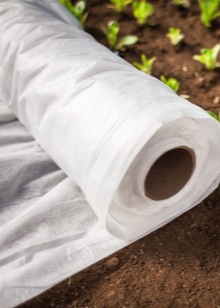
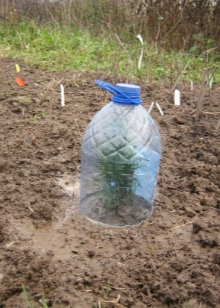
Diseases and pests
Like any ephedra, thuja is often attacked by pests and becomes a target for many infectious diseases. The most common ailment is the so-called "rust" - it is characterized by brown or pale orange needles. In order to protect thuja from this disease, the tree should be treated with a solution of copper sulfate. The processing itself should be carried out at the beginning of the spring season or in the middle of the autumn, while both the outer part of the thuja and the inner branches and needles are processed.
Preventive treatment of thuja should be carried out at least once a year - preferably in the fall or just before spring - this way you will protect the needles from infections and pests.

For the treatment of needles from diseases and pests, it is worth choosing different chemical products, moreover, processing should not be carried out at the same time, but with a short break.
- The following drugs are useful for diseases and infections of thuja: copper or iron vitriol, Bordeaux mixture (10 grams per 10 liters of water - for prevention, 30 grams - for thorough treatment).
- For insects and pests, you need Actellik and Fufanon-Nova insecticides. Before use, be sure to pay attention to the instructions.
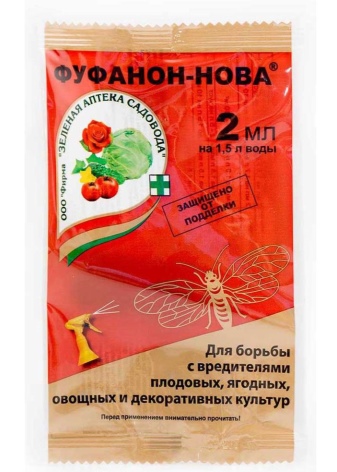
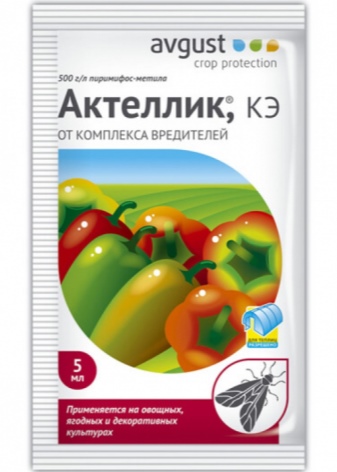
For information on how to properly plant the thuja and take care of it, see the next video.



































































The comment was sent successfully.